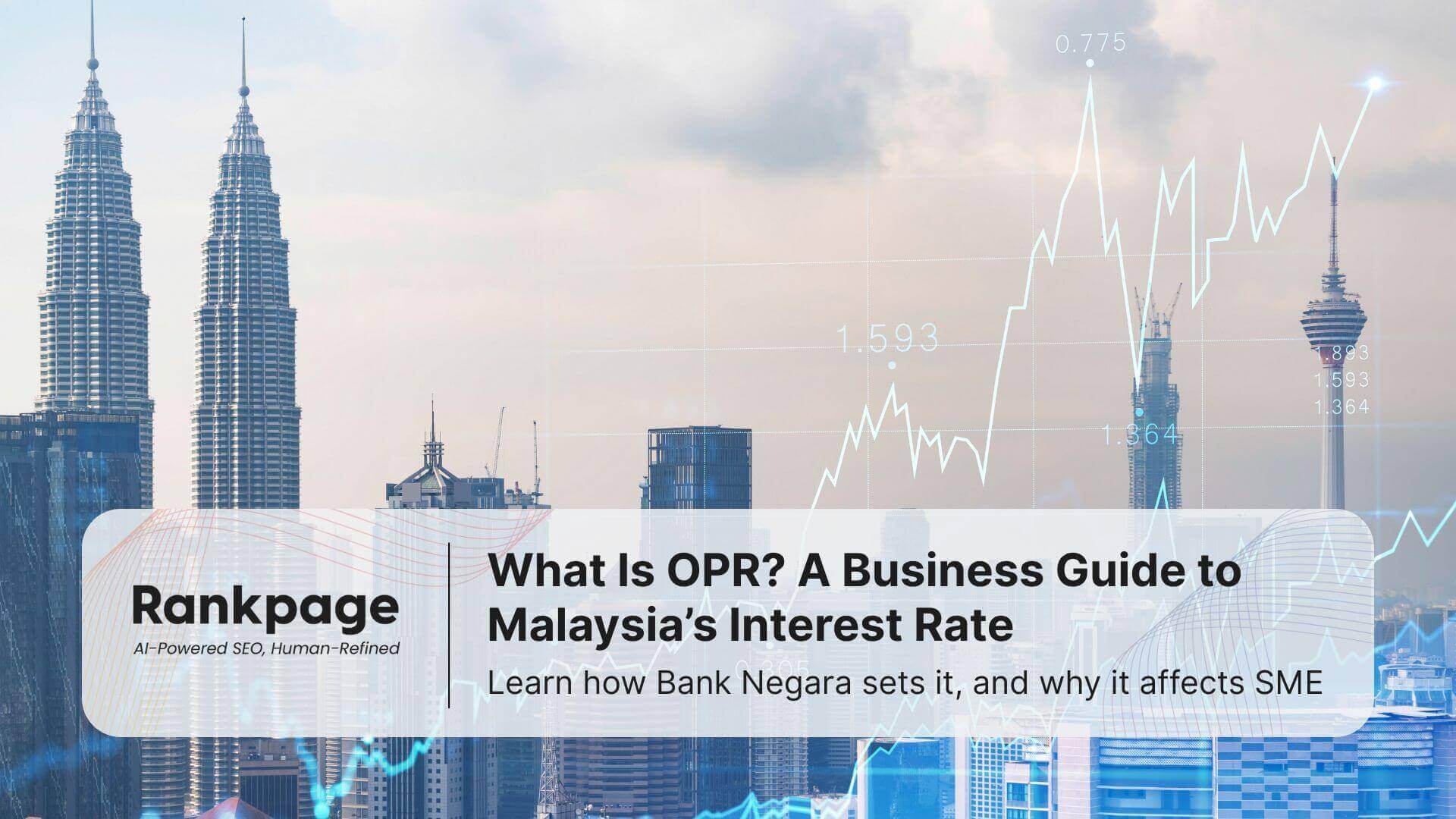Key Takeaways
- OPR = Malaysia’s key interest rate, determined by Bank Negara Malaysia (BNM) to control inflation and support the economy.
- Affects all lending rates, including SME loans, mortgages, and credit cards.
- When OPR goes up, loans become costlier; when it drops, borrowing becomes cheaper.
- Bank Negara reviews OPR six times a year during Monetary Policy Committee (MPC) meetings.
- Malaysian businesses should track OPR closely, especially when planning for financing, expansions, or debt servicing.
OPR stands for Overnight Policy Rate, Malaysia’s benchmark interest rate set by Bank Negara Malaysia (BNM). It influences how expensive or affordable borrowing becomes, directly impacting business loans, credit rates, and overall financial decisions for Malaysian companies.
For Malaysian SMEs, interest rate shifts aren’t just economic headlines, they’re operational headaches.
Today, we’ll explain exactly what OPR is, how it’s set, why it matters for your business, and how to make smarter financing decisions based on rate changes, without needing a PhD in economics
Table of Contents
What Is OPR in Malaysia and Who Sets It?
OPR is basically Malaysia’s official interest rate, set by BNM.
Think of it as the “reference price” for money between banks. BNM makes sure that when banks lend to each other overnight, the rate they charge stays close to the OPR.
When the OPR changes, it creates ripple effects that influence:
- SME business loans and working capital financing
- Hire purchase agreements for company vehicles or machinery
- Mortgages and housing loans for property buyers
- Credit card interest rates
- Even supplier financing terms for day-to-day operations
Every business in Malaysia gets affected because it affects cashflow, margins and operational cost.
Who Sets the Malaysia OPR Rate?
It’s decided by BNM’s Monetary Policy Committee (MPC), a group of economists and policymakers who assess the economic environment and vote on whether to:
- Raise the OPR to slow down inflation
- Lower the OPR to stimulate spending and growth
- Maintain the current rate if the economy is stable
In simple terms, BNM uses the OPR as its main tool to manage inflation, growth, and financial stability for the country.
How Often Is the Malaysia OPR Reviewed?
The MPC meets six times a year, following a fixed calendar. Each meeting considers key indicators like:
- Inflation trends (CPI, core inflation)
- Domestic economic performance (GDP growth)
- Global economic shifts (US Fed rates, oil prices)
- Currency movements (Ringgit stability)
- Financial market conditions
Example
- During COVID-19, Bank Negara slashed the OPR to 1.75%, the lowest in history, to encourage businesses and consumers to borrow, spend, and invest.
- In 2023–2024, as inflation crept up, the OPR was gradually increased to cool demand and restore balance, directly affecting loan repayments for thousands of SMEs.
How Does OPR Affect Malaysian Businesses?
Bank Negara doesn’t need to walk into your boardroom (or business) to affect your balance sheet. Every time the OPR moves, so does your cost of capital.
If you’re:
- Applying for a loan to expand operations
- Managing supplier terms or rolling cashflow
- Adjusting prices or margins to stay competitive
You’re already playing in OPR territory.
Even a modest change can alter the math on profitability, cash flow, or loan serviceability, especially if your business runs on leverage or credit terms.
Higher OPR = Higher Borrowing Costs
If your SME has an active floating-rate loan (and most do), a hike in the OPR can hurt. Even a 0.25% increase often leads to higher monthly repayments on:
- Business term loans
- Overdraft facilities
- Hire purchase agreements
- Working capital lines
This eats into your cash flow, especially if you’re already operating on tight margins.
Lower OPR = Cheaper Credit
When Bank Negara reduces the OPR, banks typically lower their Base Rate (BR) or Base Lending Rate (BLR). That means lower interest rates for:
- New loan applications
- Refinancing deals
- Overdraft renewals
Lower OPR encourages investment, hiring, and stock replenishment, very important for SME growth.
Scenario Comparison Table
Business Scenario | OPR Increases 🔺 | OPR Decreases 🔻 |
Loan Interest Rates | Go up (higher repayments) | Go down (lower repayments) |
Loan Approvals | Stricter (banks tighten lending) | Easier (loans become attractive) |
Customer Demand | Weakens (reduced spending) | Strengthens (more purchasing) |
Planning Outlook | Defensive, cost-cutting | Growth-oriented, expansion-ready |
Read more: Sdn Bhd / Sole Proprietorship / LLP: Which One Right for You?
Difference Between OPR, SBR/BR, and BLR
Malaysians love acronyms, but they don’t always make finance clearer.
If you’re running a business, terms like OPR, SB, and BR often show up in your loan documents, and they can sound interchangeable. But in reality, they each play a very different role in how much interest you pay.
Who Sets What?
Term | Stands For | Who Sets It | What It Affects (in simple terms) |
OPR | Overnight Policy Rate | BNM (MPC) | BNM’s main policy rate that steers all other interest rates. When OPR moves, banks’ reference rates and loan rates usually follow. |
SBR (SB) | Standardised Base Rate | Banks (framework by BNM; moves 1-for-1 with OPR) | The common reference rate for new retail floating-rate loans (many home/personal loans). Banks then add a spread on top for your actual loan rate. |
BR | Base Rate | Individual banks | A bank’s own reference rate, influenced by OPR + the bank’s costs. Common for business/SME loans and some older retail facilities; pricing is BR + spread. |
BLR | Base Lending Rate | Legacy benchmark (pre-2015) | The old reference rate for retail loans. Mostly replaced by BR/SBR in new financing, but still appears in older contracts. |
So How Do They Work Together?
- BNM sets the OPR, which influences the cost of funds for banks.
- Banks use OPR as a baseline when calculating their own Base Rate (BR).
- Your business loan interest rate = BR + spread (bank’s profit margin, risk profile).
- Older loans may still reference BLR, but most new financing uses BR.
“Think of OPR as the central control knob. When BNM turns it up or down, banks adjust their own dials (BR), and you feel the heat (or relief) in your loan repayments.”
Why This Matters to Businesses
- If you’re taking a new retail floating loan, ask if it’s priced off SBR + spread.
- For SME/business loans, you’ll often see BR + spread.
- Still on BLR? It’s legacy and its worth reviewing if refinancing is on the table.
When Does Bank Negara Change the OPR?
As mentioned, rate changes are only considered during six pre-scheduled Monetary Policy Committee (MPC) meetings each year.
These dates are announced by BNM at the start of each year, allowing businesses, banks, and analysts to anticipate and prepare.
Factors That Influence OPR Decisions
Each MPC meeting involves a detailed review of Malaysia’s macroeconomic health and financial stability. The committee considers a wide range of indicators, including:
- GDP Growth Projections
Is the economy expanding at a sustainable pace or overheating? - Inflation Rates
Consumer Price Index (CPI) and core inflation help signal rising cost pressures. - Global Economic Conditions
What’s happening in the US, China, or oil markets may ripple into Malaysia. - Exchange Rate Volatility
A weakening Ringgit can influence import prices and inflation. - Fiscal Policy Changes
Government moves like SST hikes, fuel subsidies, or cash aid programs can impact demand.
2025 MPC Meeting Schedule
Meeting | Month (2025) | What to Expect |
#1 | January 22 | Yearly policy direction; early tone-setting |
#2 | March 6 | Post-Budget 2025 reactions; inflation watch |
#3 | May 8 | Mid-year performance review checkpoint |
#4 | July 9 | Key decisions on growth vs. inflation |
#5 | September 4 | Adjustments to global or regional shifts |
#6 | November 6 | Final calibration before year-end holidays |
Loan interest rates don’t always change overnight, but banks typically revise their base rates within 1–3 weeks after an OPR change.
“Bank Negara Malaysia lowered its Overnight Policy Rate (OPR) by 25 basis points to 2.75% from 3.00%, marking the first rate cut in five years.” — Reuters, July 2025
How to Plan Your Business Financing Around OPR Changes
In Malaysia, many SMEs rely on financing tools like term loans, hire purchase, and working capital facilities from banks such as Maybank, CIMB, RHB, and OCBC.
When Bank Negara adjusts the OPR it affects not only your cost of borrowing, but also how lenders assess your eligibility, risk profile, and even loan tenure options.
Here’s how to approach financing in both rising and falling OPR environments:
If the OPR Is Rising (Tightening Phase)
When OPR increases, so do lending rates , including Base Rate (BR) and BLR.
Banks become more conservative, and SMEs may face higher financing costs and stricter approvals.
What You Should Do:
- Lock in fixed-rate loans now, especially for equipment financing, commercial property loans, or vehicle hire purchases.
Example: If you’re buying new vans for your logistics business, a fixed-rate plan could shield you from rate hikes in the next 12–24 months.
- Review existing loan terms for refinancing potential.
If you’re on a variable-rate facility, consider negotiating with your relationship manager to switch to a fixed or capped-rate loan. - Delay discretionary borrowing unless urgently needed.
Avoid taking on debt for speculative projects, such as new store openings or product lines, unless the ROI is very clear. - Tighten internal credit policies.
If you extend 30–60 day terms to clients, rising OPR may mean slower receivables. Monitor late payments and review limits.
If the OPR Is Falling (Easing Phase)
A lower OPR signals cheaper financing, and may be an opportunity to grow, restructure, or reduce costs through better loan terms.
What You Should Do:
- Explore financing for growth:
Invest in automation, expand warehousing, or upgrade your digital infrastructure. Cheaper capital = lower long-term cost of investment.Example: A Johor-based F&B distributor used lower OPR periods to invest in cold-chain logistics, increasing margins and reducing spoilage.
- Restructure or consolidate existing debts:
Merge multiple credit lines or high-interest facilities into one lower-cost facility. Consider a term loan with a longer tenure to improve cash flow predictability. - Renegotiate supplier or vendor credit terms:
With lower financing costs, suppliers may extend better payment terms. Use this as leverage to negotiate 60–90 day terms to ease short-term cash constraints. - Secure standby facilities
Even if you don’t need it now, banks are more willing to approve working capital buffers during low-OPR periods. Get approved before the next rate hike cycle.
Match Financing Type to Asset Type
Business Asset | Best Financing Type | Recommended Rate Type |
Factory Equipment | Term Loan or Hire Purchase | Fixed or capped |
Company Vehicles | Hire Purchase | Fixed |
Software / IT Infrastructure | Business Term Loan | Variable (short tenure OK) |
Daily Operations / Inventory | Revolving Credit or Overdraft | Variable |
Expansion (New Location) | Property Loan | Fixed or semi-flexible hybrid |
Conclusion: OPR Isn’t Just for Economists, It Affects You Too
From SME loans to inflation management, OPR is a silent driver of Malaysia’s business economy.
Regardless if you’re managing a team of 5 or leading a scaling enterprise, keeping an eye on Bank Negara’s rate decisions can help you make smarter, more cost-effective decisions.
If you plan your business, plan for OPR as well when taking that credit loan.
At Rankpage, we don’t control interest rates, but we do help your business get discovered when OPR changes make headlines.
Whether you’re in property, finance, or SME services, our SEO and AEO strategies put you in front of the right search traffic, right when people are looking.
As the leading SEO agency in Malaysia, we have what it takes to put your business (and interest) on the top.
Disclaimer: This article is for general information only and is not financial, investment, tax, or legal advice. Rates and policies (including OPR/SBR/BR) can change and info is current as of the publication date.
Frequently Asked Questions About OPR Malaysia
What is the OPR rate in Malaysia 2025?
The OPR is 2.75% as of July 9 set by Bank Negara Malaysia. It may change based on inflation and economic growth.
How does OPR affect SME loans in Malaysia?
OPR influences your bank’s lending rate. When OPR increases, interest on SME loans typically goes up too.
Is OPR the same as BLR or BR?
No. OPR is set by Bank Negara; BLR/BR is determined by banks and follows the OPR closely.
Why does Bank Negara change the OPR?
To stabilise inflation, support economic growth, or react to global conditions.
Can Malaysian businesses predict OPR movements?
While exact changes can’t be predicted, watching inflation reports and MPC meeting dates can offer clues.
How often is the OPR reviewed?
Six times a year during Bank Negara’s MPC meetings.





